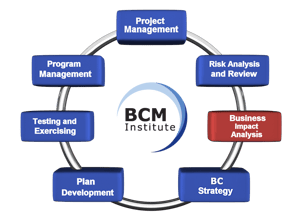 Documenting Your Business Impact Analysis Report and Presenting Findings
Documenting Your Business Impact Analysis Report and Presenting Findings
As part of the BCM-5000 Module 3 Pre-reading List, this section prepares you to compile and present the Business Impact Analysis (BIA) report to Executive Management—a pivotal step in your journey toward effective business continuity planning.
Upon completing BCM-300 or BCM-5000 Module 2, you will have developed the competencies of a Business Unit (BU) BCM Coordinator. This includes the critical task of completing the BIA Questionnaires, a foundational exercise that allows you to grasp the objectives and challenges faced at the business unit level.
Advancing into Modules 3 and 4, your role expands to that of an Organisation BCM Coordinator. In this capacity, you are responsible for analysing the data gathered and crafting a comprehensive BIA report. This report serves as a strategic tool, highlighting the potential impacts of disruptions and identifying key areas requiring resilience measures.
Presenting the BIA findings to Executive Management is more than just a formality—it is an opportunity to advocate for the necessary resources and support to strengthen your organization’s continuity capabilities. An effective presentation ensures senior leaders understand the significance of identified risks and the importance of mitigating actions.
The guidance for this process is derived from the BCM Planning Series: Conducting Your Impact Analysis for Business Continuity Planning (Second Edition). Mastering this documentation and presentation process empowers you to translate technical assessments into actionable insights, ultimately fostering a resilient organizational culture.
Document and Present Your Business Impact Analysis Document and Present Findings
![]()
 This is the final stage, where you generate a report which describes, in simple “dollars and cents” terms, how bad it would be if a disaster struck.
This is the final stage, where you generate a report which describes, in simple “dollars and cents” terms, how bad it would be if a disaster struck.
The BIA report is the document you and others will refer to as you develop a comprehensive BCM plan.
The Organisation BCM Coordinator should present the BIA findings in person to the Executive Management.
While any significant study of business functions will reveal some surprises, this BIA report should not be a total surprise to anyone who has been involved in the process.
In this respect, reviewing your findings with the Heads of BU before presenting them to the Executive Management is vital.
This blog provides suggestions on preparing and presenting the BIA report.
Preparing the BIA Report
 The production of the BIA report is the final stage of the BIA process. This report is an executive summary containing the introduction, conclusions and major recommendations.
The production of the BIA report is the final stage of the BIA process. This report is an executive summary containing the introduction, conclusions and major recommendations.

You will be very familiar with the organisation's overall operations by this stage.
However, others reading your report may not benefit from such experience or knowledge, especially those reading it months after the BIA is conducted.
Hence, ensuring that the document is sufficiently detailed and sensitive to the passage of time is vital.
While developing your final BIA report, keep these steps in mind:
- Issue a draft BIA report to participating Heads of BU and request feedback
- Review the feedback and, where appropriate, revise the findings or add on outstanding issues
- Schedule a workshop or meeting with participating Heads of BU to discuss initial findings, if necessary
- Update original findings to reflect changes arising from meetings
- Prepare the final BIA report according to organizational standards
- Make a formal presentation of the findings to peers and the Executive Management.
Design & Prepare BIA Report Format
The report should include background information to bring all readers a common understanding and avoid unnecessary and irrelevant questions. The report may be structured as follows:
- Why was the BIA conducted?
- What were the objectives set?
- What was the scope of the exercise?
- What was the approach that you used?
- What were the detailed findings?
- What were the conclusions and recommendations?
 This methodology will undoubtedly produce an extensive and detailed report, mainly if you use graphs, tables and diagrams. However, very few people need to read the report in its entirety.
This methodology will undoubtedly produce an extensive and detailed report, mainly if you use graphs, tables and diagrams. However, very few people need to read the report in its entirety.A sample of the Table of Contents for a typical BIA report can be found in Sample BIA Report Format provided during the course.
Critique and Rationalisation of Report
 I always recommend submitting a draft report to the BCP project team, usually consisting of BU BCM Coordinators and the project sponsor, for their perusal and ratification.
I always recommend submitting a draft report to the BCP project team, usually consisting of BU BCM Coordinators and the project sponsor, for their perusal and ratification.
There is nearly always a need for someone to critique and rationalize the business unit content.
For example, the training business unit may insist on recovering 50 per cent of employee strength within a week, but executive management may feel differently.
As the Organisation BCM Coordinator, you can suggest that the requirement seems unrealistic; however, if the participant insists, you must include their input, hence the importance of rationalisation.
Once the BIA report is completed, it will highlight the CBFs and where an incident's impact is most important.
You will have indicated your current level of preparedness and made recommendations for improvement in regular working practice and in an emergency.
Lastly, you will provide a blueprint for the continuity and recovery of the entire organisation's business functions.
Obtain Acceptance by Management
To manage Executive Management’s expectations, the report needs to describe the key problem, “What is the current state concerning the solution?” and, most of all, “What is required from them?”
Executive Management Members often do not realise they are the only ones who can authorise using resources for the BCM planning process.
The Executive Management needs to know:
- What is required?
- Why is it required?
- When is it required?
- How much will it cost?
 I recommend a typical BIA report of around twenty pages (including appendices). However, this is too long for the Executive Management. Hence, an executive summary and a concise set of recommendations should exist.
I recommend a typical BIA report of around twenty pages (including appendices). However, this is too long for the Executive Management. Hence, an executive summary and a concise set of recommendations should exist.Presentation & Acceptance of Findings
If possible, the presentation to the Executive Management should be held in the Boardroom, lasting about twenty to thirty minutes. The goals of the presentation are:
- Provide information about the impacts of disruption to the organization
- Obtain acceptance of the findings of the BIA report
- Seek approval on the direction of BC Strategy development for the mitigating of potential impacts
- Build a case for developing a BC planning program
Should I Use A BC Software?
 I am never for or against using specialized software as long as it meets 80% of my functional requirements.
I am never for or against using specialized software as long as it meets 80% of my functional requirements.Presentation to Executive Management
The presentation should focus on the highest-priority business functions and IT applications. The analysis results should be presented in tabular or graphical format.
After presenting the results, the Organisation BCM Coordinator should state the priorities assigned to business units and IT applications and the maximum tolerable downtimes or RTOs.
 I want to caution that the BIA conclusion may seem obvious but is not always valid. Avoid the obvious in a BIA and seek expertise at various levels to obtain consensus.
I want to caution that the BIA conclusion may seem obvious but is not always valid. Avoid the obvious in a BIA and seek expertise at various levels to obtain consensus.Alternative Format of Presentation
The BIA report is presented to the Executive Management in written and oral form. The report should include an overview of the BIA process, summarising:
- Data gathering and analysis methodology
- A summary of your findings
- Charts and graphs should be used to illustrate financial information, potential market share losses, number of customers that could be lost and other numerical information
- Recommendations
 While you should have already validated business unit information, you will want to review the initial drafts of your report to the Executive Management. The executive management may have a very different view of recovery priorities from that of the head of BU.
While you should have already validated business unit information, you will want to review the initial drafts of your report to the Executive Management. The executive management may have a very different view of recovery priorities from that of the head of BU.
 Seek Approval of Document
Seek Approval of Document
The final step of documenting the Executive Management decision is often missing.
More Information About Business Continuity Management Courses
To learn more about the course and schedule, click the buttons below for the BCM-300 Business Continuity Management Implementer [BCM-3] and the BCM-5000 Business Continuity Management Expert Implementer [BCM-5].





![Register [BL-B-3]*](https://no-cache.hubspot.com/cta/default/3893111/ac6cf073-4cdd-4541-91ed-889f731d5076.png)



![FAQ [BL-B-3]](https://no-cache.hubspot.com/cta/default/3893111/b3824ba1-7aa1-4eb6-bef8-94f57121c5ae.png)
![Email to Sales Team [BCM Institute]](https://no-cache.hubspot.com/cta/default/3893111/3c53daeb-2836-4843-b0e0-645baee2ab9e.png)





